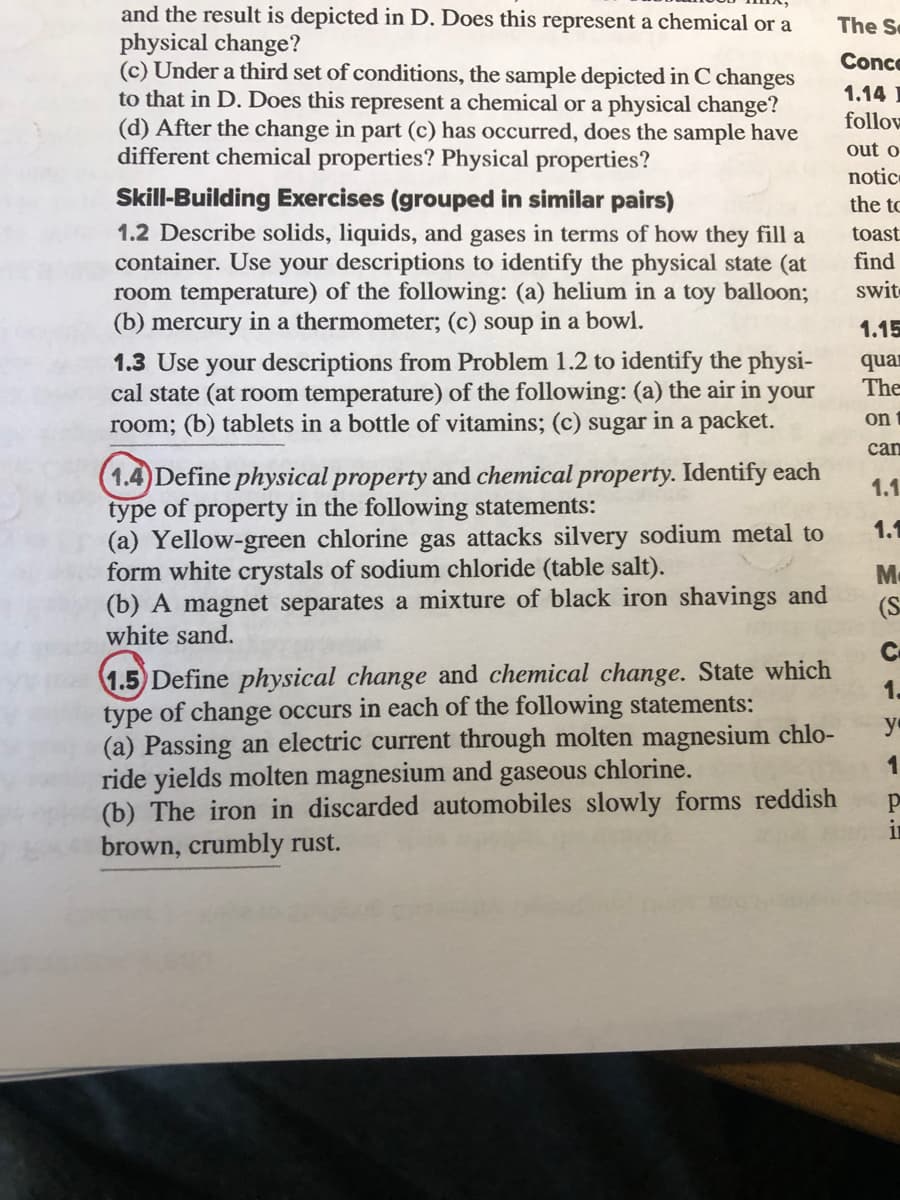room; (b) tablets in a bottle ofI vitamins 1.4)Define physical property and chemical property. Identify each type of property in the following statements: (a) Yellow-green chlorine gas attacks silvery sodium metal to form white crystals of sodium chloride (table salt). (b) A magnet separates a mixture of black iron shavings and white sand. 1.5 Define physical change and chemical change. State which type of change occurs in each of the following statements: (a) Passing an electric current through molten magnesium chlo- ride yields molten magnesium and gaseous chlorine. (b) The iron in discarded automobiles slowly forms reddish brown, crumbly rust.
room; (b) tablets in a bottle ofI vitamins 1.4)Define physical property and chemical property. Identify each type of property in the following statements: (a) Yellow-green chlorine gas attacks silvery sodium metal to form white crystals of sodium chloride (table salt). (b) A magnet separates a mixture of black iron shavings and white sand. 1.5 Define physical change and chemical change. State which type of change occurs in each of the following statements: (a) Passing an electric current through molten magnesium chlo- ride yields molten magnesium and gaseous chlorine. (b) The iron in discarded automobiles slowly forms reddish brown, crumbly rust.
Chemistry: Principles and Reactions
8th Edition
ISBN:9781305079373
Author:William L. Masterton, Cecile N. Hurley
Publisher:William L. Masterton, Cecile N. Hurley
Chapter1: Matter And Measurements
Section: Chapter Questions
Problem 38QAP: A gasoline station in Manila, Philippines, charges 38.46 pesos per liter of unleaded gasoline at a...
Related questions
Question
100%
I don’t understand these two questions.

Transcribed Image Text:and the result is depicted in D. Does this represent a chemical or a
physical change?
(c) Under a third set of conditions, the sample depicted in C changes
to that in D. Does this represent a chemical or a physical change?
(d) After the change in part (c) has occurred, does the sample have
different chemical properties? Physical properties?
The Se
Conce
1.14 I
follow
out o
notic
Skill-Building Exercises (grouped in similar pairs)
1.2 Describe solids, liquids, and gases in terms of how they fill a
container. Use your descriptions to identify the physical state (at
room temperature) of the following: (a) helium in a toy balloon;
(b) mercury in a thermometer; (c) soup in a bowl.
the to
toast
find
swit
1.15
1.3 Use your descriptions from Problem 1.2 to identify the physi-
cal state (at room temperature) of the following: (a) the air in your
room; (b) tablets in a bottle of vitamins; (c) sugar in a packet.
quan
The
on
can
1.4)Define physical property and chemical property. Identify each
type of property in the following statements:
(a) Yellow-green chlorine gas attacks silvery sodium metal to
form white crystals of sodium chloride (table salt).
(b) A magnet separates a mixture of black iron shavings and
white sand.
1.1
1.1
Mc
(S
C.
1.5 Define physical change and chemical change. State which
type of change occurs in each of the following statements:
(a) Passing an electric current through molten magnesium chlo-
ride yields molten magnesium and
(b) The iron in discarded automobiles slowly forms reddish
brown, crumbly rust.
1.
y
gaseous chlorine.
11
Expert Solution
This question has been solved!
Explore an expertly crafted, step-by-step solution for a thorough understanding of key concepts.
This is a popular solution!
Trending now
This is a popular solution!
Step by step
Solved in 3 steps

Knowledge Booster
Learn more about
Need a deep-dive on the concept behind this application? Look no further. Learn more about this topic, chemistry and related others by exploring similar questions and additional content below.Recommended textbooks for you

Chemistry: Principles and Reactions
Chemistry
ISBN:
9781305079373
Author:
William L. Masterton, Cecile N. Hurley
Publisher:
Cengage Learning

Chemistry for Today: General, Organic, and Bioche…
Chemistry
ISBN:
9781305960060
Author:
Spencer L. Seager, Michael R. Slabaugh, Maren S. Hansen
Publisher:
Cengage Learning

Chemistry & Chemical Reactivity
Chemistry
ISBN:
9781133949640
Author:
John C. Kotz, Paul M. Treichel, John Townsend, David Treichel
Publisher:
Cengage Learning

Chemistry: Principles and Reactions
Chemistry
ISBN:
9781305079373
Author:
William L. Masterton, Cecile N. Hurley
Publisher:
Cengage Learning

Chemistry for Today: General, Organic, and Bioche…
Chemistry
ISBN:
9781305960060
Author:
Spencer L. Seager, Michael R. Slabaugh, Maren S. Hansen
Publisher:
Cengage Learning

Chemistry & Chemical Reactivity
Chemistry
ISBN:
9781133949640
Author:
John C. Kotz, Paul M. Treichel, John Townsend, David Treichel
Publisher:
Cengage Learning

Chemistry & Chemical Reactivity
Chemistry
ISBN:
9781337399074
Author:
John C. Kotz, Paul M. Treichel, John Townsend, David Treichel
Publisher:
Cengage Learning

Introductory Chemistry: A Foundation
Chemistry
ISBN:
9781337399425
Author:
Steven S. Zumdahl, Donald J. DeCoste
Publisher:
Cengage Learning

Introductory Chemistry: An Active Learning Approa…
Chemistry
ISBN:
9781305079250
Author:
Mark S. Cracolice, Ed Peters
Publisher:
Cengage Learning